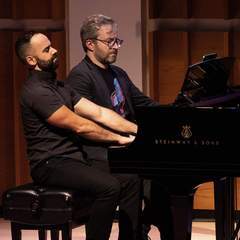|
Back
One-Hundred and Seventy-Six Keys New York
Merkin Hall and Kaufman Music Center
11/28/2023 -
Steve Martland: Drill
Julius Eastman: Gay Guerilla
Adam Tendler, Conor Hanick (Pianists)

A. Tendler/C. Hanick (© Kaufman Music Center)
“What I am trying to achieve is to be what I am to the fullest—Black to the fullest, a musician to the fullest, and a homosexual to the fullest. It is important that I learn how to be, by that I mean accept everything about me.”
Julian Eastman
“Creativity is everything that is against what’s going on in the world right now. It’s to do with tolerance and understanding other people.”
Steve Martland
The last century was packed with an external coterie of gay composers. In America, Copland, Blitzstein, Barber, Strayhorn, Rorem, Cowell etc. In U.K., Tippett, Britten, Davies. Yet underneath these celebrated artists were gay composers concealed from the populace. Not because of their sexuality. But because they never played the game of popularity. Not following political whims, grasping for commissions, they went their own solitary ways.
Two of them were on display at Kaufman Concert Hall last night. Yet neither Julius Eastman or Steve Martland, both dying in their 50’s, were socially solitary. Julius Eastman, a prodigy from Curtis Institute, studied with Boulez, palled around with Feldman and the whole California school of composers until his last years, when he secreted himself and died far too young.
Martland was successful enough, writing music in England for ballet and concert hall, played in orchestras himself, was a fearless believer in music education and a most prolific composer. He died from a heart attack in his sleep.
What both Eastman and Martland contributed last night were two extraordinary–and unclassifiable–piece for two pianos.I had heard Conor Hanick several times before. But when I heard Adam Tendler perform the complete John Cage Sonatas and Interludes in the Crypt of the Church of the Intercession last September, I was hooked. He turned Cage into Chopin, he sculpted the most variegated notes into resonant hymns, and I had to hear him again.
The wait was worth it. Both Martland and Eastman each journeyed on a pair of 30‑minute adventures for 176 keys. Both utterly contrasting, they had a different vision of a keyboard universe.
Martland’s Drill, written in 1987 (just after his Big Mac Ii!!) was based on two keys–A and A‑flat–resembling a cantus firmus for all six completed movements. The two pianists moved from their minor-second notes to silences. Short or long, note foreseen.
Now Mr. Tendler was resonating on the top keys, like Rachmaninoff’s simulation of Russian church bells in his piano works.
Without stopping, these same dissonant keys started a movement of syncopated jazz. Part boogie-woogies, part free‑form Coleman Hawkins style. And now it segued into more and more complex chords (many from Stravinsky’s Sacre), with extreme virtuosity for both pianos. And then, not abruptly but as if preordained, the two artists became more silent, back to the original chords, the original silences.
Drill took around 30 minutes, but such were the changes that I, for one, was drawn into this miniature galaxy.

J. Eastman/S. Martland (© Undated,unknown/Henrietta Butler/Arenapal)
After Gay Guerilla, I felt that Julian Eastman had learned about painting–especially Mark Rothko–by his art‑loving friend Morton Feldman. Paint is space, music is time. Yet Eastman gave (perhaps unconsciously) a musical verisimilitude to creating a spatial work of art.
In this case, both pianists started using a blank square canvas with a black dot in the middle. In this case, the vanilla meter of four‑four, with a B‑flat repeated by itself over and over again.
Now imagine Rothko (or any other abstract painter) drawing a line here, a circle there around that black dot (the B‑flat), continuing with a splash of paint here, a splattering there, a can of paint thrown here (pace, Mr. Pollock), a barrel of motley materials there. All keeping that black dot–-the single note repeated, from eighth notes to 16th notes–in the foreground.
Actually a kind minimalism the opposite of Philip Glass. The latter repeated his motifs over and over in different shapes. Julian Eastman didn’t have a motif. These were notes overpowering each other until a surprise near the end.
Gay Guerilla, obviously a whimsical term, went from simplicity to wild extravagance For breaking out in the morass were a few recognizable measures, these measure transmogrifying into Martin Luther’s Ein feste Burg, then returning to the repetitions.
The secret for both Hanick and Tendler was synchronizing these precise notes in each work. They managed it with accuracy, emotion and joy. For revealing the works of Eastman and Martland, they created a second revelation of depth and (in E.E. Cumming’s words) a “universe next door”.
Harry Rolnick
|